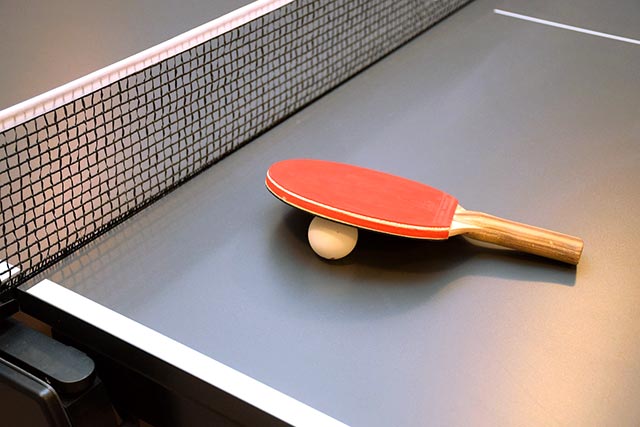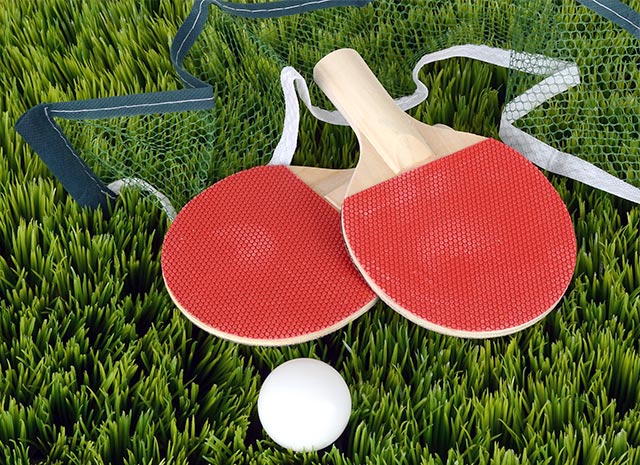


Table tennis, also called ping-pong, is a ball game played on a flat table divided into two equal places by a net fixed in the middle across its width. The aim is to hit the ball so that it goes over the net and bounces on the opponent's half of the table in such a way that the opponent cannot reach it or hit it back properly. The light hollow ball is propelled back and forth over the net by small bats held by the players.
The game is popular all over the world. In most countries it is very well organized as a competitive sport, especially in Europe and Asia, but in the media, so I am now talking about Germany, it is treated rather stepmotherly and receives little attention. Also in the minds of many people "Ping Pong" is not a real sport, but only a game for children, which is a great pity, because first of all it is a real challenge because of the high speeds at which the ball is played and secondly there is a table tennis club in almost every village. A few years ago table tennis even made it into the top ten most popular sports in Germany, which is probably no longer the case today. According to statista table tennis is only the 20th most popular sport in Germany.
The game was invented in England in the early days of the 20th century and was originally called Ping-Pong, a trade name. The name table tennis was adopted in 1921-22 when the old table tennis club, founded in 1902, was revived. The original club had been dissolved around 1905, although the game apparently continued to be played in parts of England outside London and was played in many countries during the 1920s. In 1926, under the leadership of representatives from Germany, Hungary and England, the Fédération Internationale de Tennis de Table (International Table Tennis Federation) was founded. Its founding members are England, Sweden, Germany, Hungary, India, Denmark, Czechoslovakia, Austria and Wales. By the mid-1990s, more than 165 national federations were members.
The first World Championships were held in London in 1926 and were dominated by players from Central Europe until 1939, with the men's doubles being won nine times by Hungary and twice by Czechoslovakia. By the mid-1950s Asia had become a breeding ground for champions, and since then men's doubles have been won by either Japan or China, as well as women's doubles, though to a lesser extent; North Korea also became an international force. In 1980 the first World Cup was held and Guo Yuehua from China won the first prize of $12,500. Table tennis became an Olympic sport in 1988, with singles and doubles competitions for men and women.
The table tennis equipment is relatively simple and inexpensive. The table is rectangular, 2.7 meters by 1.5 meters (9 feet by 5 feet), its top is a flat surface that stands 76 cm (30 inches) above the ground. The net is 1.8 meters long, and its top edge along its entire length is 15.25 cm (4 inches) above the playing surface. The ball, which is spherical and hollow, was once made of white celluloid. A celluloid-like plastic has been used since 1969. The ball, which can be white, yellow or orange, weighs about 2.7 grams (0.09 ounces) and has a diameter of about 4 cm (1.6 inches). The club is usually made of wood, is flat and stiff, and may be covered on each side with a thin layer of pimpled rubber that can be placed over a thin layer of foam rubber. The studs can face inwards or outwards. Whatever combination is used, each side of a club must be a different colour.

In 2001 the balls were changed from a diameter of 38mm to 40mm, which made the balls a bit slower. 2001 was also the year in which the sets were only played up to 11 points, with three winning sets. Before that there were two winning sets, which were played up to 21 points.
In July 2014 there was the next change, because the table tennis balls formerly made of celluloid will from then on only be made of plastic. The reason for this is the easy flammability of cellulose, which caused table tennis balls to explode during production (probably the reason why table tennis balls are nowadays only produced in China) and were classified as dangerous goods during transport. For the 2019/2020 season it is mandatory that only plastic table tennis balls are used in all German table tennis leagues and competitions.
The first player to be drawn is the one who starts. This player may then start a rally twice as a result of the serve, then the service changes hands after every two points until 10 points are reached. The player who first reaches 11 points or who wins two clear points ahead after every 10 points wins. One point is scored if the server makes a mistake, if one of the two players cannot return the ball or if a player commits a rule violation (e.g. touches the court with a free hand while the ball is in play).
The serve is made behind the end of the table, with the serve player throwing the ball upwards out of the palm of the free hand and, when it falls, hitting it so that it bounces first on his own half of the court and then, over the net, on the opponent's side of the court. On serve, the ball must not be given any spin by the fingers. This was not always the case. The so-called "fingerspin" reached a stage, especially in the United States, that the game became a farce and therefore the "fingerspin" was banned worldwide in 1937.
The special thing about table tennis is, besides the high speed and the necessary skill of the player, to defeat the opponent with a well thought-out strategy. Increasing the speed of the game, slowing it down, varying the direction of the ball or giving the ball a different spin or speed and using gentle drops over the net are just some of the tactics that can be used to support the planned strategy.
The slow or defensive game was suddenly so dominant that at the 1936 World Championships in Prague it took an hour to decide a single point. Therefore the game was restricted and the changing method or time game was introduced, if a set lasts longer than 10 minutes, here are a few paragraphs from the rules:
The complete set of rules of the German Table Tennis Federation can be downloaded in these two PDF's: